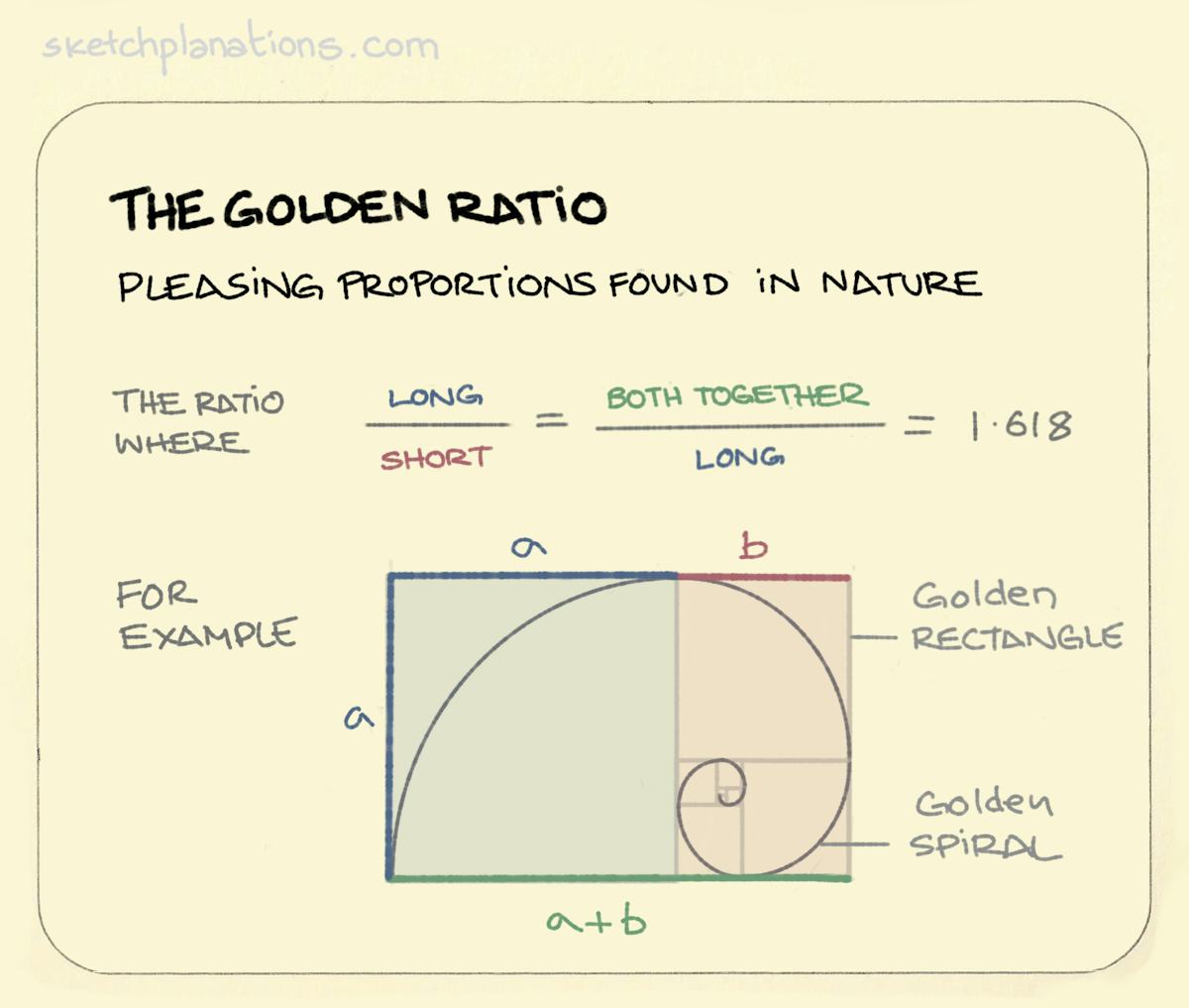Week 2: Math & Art
"The Golden Ratio" Sketchplanations.com. Accessed 12 April 2024.
The most prominent insights I have learned during this week’s topic on math and art, is through professor Victoria Vesna’s lecture. At one point, she talks about the “golden ratio” and describes it as the ultimate connection between math and art that even Egyptians used when creating the pyramids. To gain a better understanding of the “golden ratio” and its relationship with math and art, I wanted to learn more about the simplicity of the golden ratio, especially in how we can see it in art, without knowing it is there. Rosie Lesso describes the golden ratio as “a structural device based on patterns of nature.” Lesso uses Phi and the Fibonacci sequence to make it more relatable to the real world. For example, the sequence is structured like a curve, and can share similarities with galaxies, flowers, shells, and plants. One prominent example that she gives are waves, and it made me think of one particular form of art, that shares this relationship to math, which Lesso also suggests. One important thing to keep in mind is that art, like Yudhister Kumar states in his TedTalk, is that art is made by humans and expresses ideas, which also happens to be the basis for math.
"Math is Art: And why it matters" by Yudhister Kumar. TEDxTemecula. 4 Nov 2021. Accessed 12 April 2024.
The art piece I chose was “The Great Wave off Kanagawa” which, when looked through a mathematical lens, exemplifies certain aspects of math, like the Fibonacci sequence. It made me think about how math is incorporated into art, and is not something we may think about at first. I would have never thought about this painting, much like others, to be related to math, but knowing about sequences or the golden ratio can help open the doors to their relationship with one another. Similarly, Linda Dalrymple Henderson, talks about how artists incorporate math, like the fourth-dimension, which allowed for liberation for artists through visual experiences.
"What is the Golden Ratio and How Does it Apply to Art?" by Rosie Lesso. 22 March 2023. Accessed 12 April 2024.
"The Great Wave off Kanagawa" by Katsushika Hokusai. TheMET. Accessed 12 April 2024.
Learning about how artists and scientists use their respective fields to create work and expression, really changed perspective for me. Writers like Cynthia Ann Bickley-Green, write about how paintings from the Stone Age share a connection with math through their structure.
I think it is interesting how math and science, although they may seem opposite, are actually very similar. The juxtaposition of how they both involve structure and sequences, highlights a greater understanding and appreciation for the contributions of math and art.
Works Cited
Bickley-Green, Cynthia Ann. “Math and Art Curriculum Integration: A Post-Modern Foundation.” Studies
in Art Education, vol. 37, no. 1, 1995, pp. 6–18. JSTOR, https://doi.org/10.2307/1320488. Accessed 12 Apr. 2024.
Henderson, Linda Dalrymple. “The Fourth Dimension and Non-Euclidean Geometry in Modern Art:
Conclusion.” Leonardo, vol. 17, no. 3, 1984, pp. 205–10. JSTOR, https://doi.org/10.2307/1575193. Accessed 12 Apr. 2024.
"Math is Art: And why it matters." Youtube. Uploaded by TEDxTemecula. 4 November 2021.
https://youtu.be/eCptO1sv7So?feature=shared . Accessed 12 April 2024.
Lesso, Rosie. "What Is the Golden Ratio and How Does it Apply to Art?" TheCollector.com, March 22,
2023, https://www.thecollector.com/what-is-the-golden-ratio-and-how-does-it-apply-to-art/. Accessed 12 April 2024
Vesna, Victoria. "Matthematics-pt1-ZeroPerspectiveGoldenMean.mov." YouTube, 9 April 2012.
https://youtu.be/mMmq5B1LKDg . Accessed 12 April 2024.


martin, i enjoyed reading this blog post! i particularly enjoyed your discussion of the golden ratio in relation to "The Great Wave off Kanawaga". i think that is something really important to note as it not only ties the science and math into the art piece to demonstrate the beauty and aesthetic that such concepts create, but also displays that such mathematical principles, like the golden ratio, are prevalent in nature as well. a wave without being drawn or looked at or manipulated in any way will follow the golden ratio simply as its way of existence.
ReplyDelete